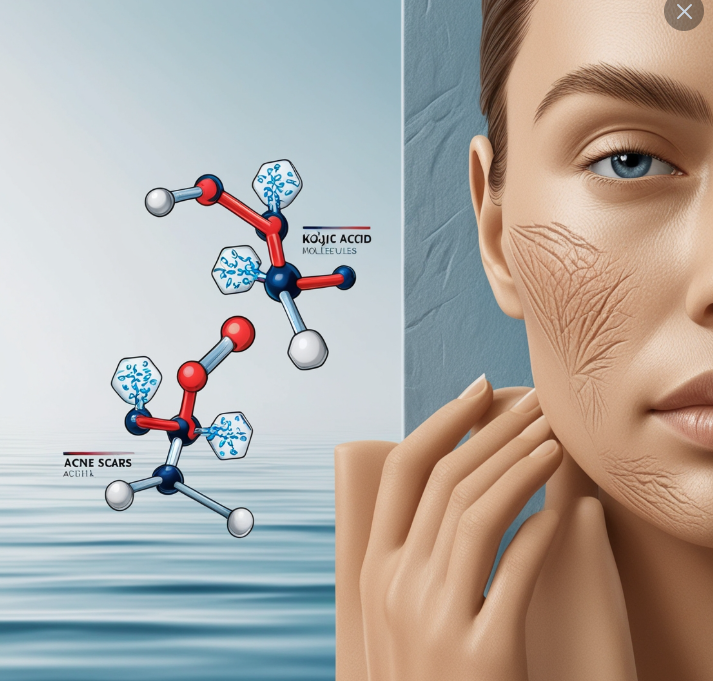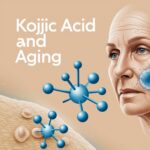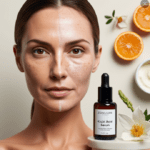Quick Takeaways
-
Kojic acid lightens hyperpigmented scars, as confirmed by research and dermatologists.
-
1% concentration is ideal for topical use to minimize irritation.
-
A 3% kojic acid preparation improved skin brightness for 75% of study participants.
-
Dermatologists recommend it for its antioxidant and exfoliant properties.
-
Real users report mixed experiences, with some praising its effectiveness and others noting harshness.
-
Sunscreen is crucial when using kojic acid due to increased sensitivity to sunlight.
Acne scars are a frustrating reminder of past breakouts, but skincare science offers hope. Kojic acid, a buzzword in the world of hyperpigmentation treatments, has been touted for its ability to lighten scars. But how effective is it? Let’s explore what research, dermatologists, and real users have to say about kojic acid’s role in fading acne scars.
The Role of Kojic Acid in Lightening Acne Scars
A review in a dermatological journal highlights kojic acid’s effectiveness in addressing hyperpigmented scars. Researchers confirm that kojic acid can lighten scars and photodamage. However, irritation may occur if concentrations are too high. The review concludes that topical products with around 1% kojic acid are safe and effective for regular use.
Another study used 3% kojic acid preparations on the post-acne skin of 12 participants. The results? 75% of participants experienced brighter skin and reduced discoloration. These findings indicate that kojic acid improves skin brightness and reduces hyperpigmentation, making it a useful treatment for acne scars.
What Do Dermatologists Say?
Dr. Shereene Idriss acknowledges kojic acid as a powerful skin-brightening agent. According to her, it doesn’t lighten overall skin tone but effectively targets discoloration caused by acne scars. Additionally, she points to kojic acid’s antimicrobial properties, which combat bacteria responsible for acne. Here is the video.
Dr. Nkem Ugonabo also highlights kojic acid’s antioxidant and exfoliant properties. She explains that it’s gentler than many other treatments for acne scars and hyperpigmentation. Its ability to address acne-causing bacteria, while reducing discoloration, makes it particularly helpful for those with darker skin tones prone to post-inflammatory hyperpigmentation.
Dermatologist-Referenced Study Findings
Dermatologists often refer to a study showing that 3% kojic acid reduces post-acne discoloration. Over time, consistent use leads to brighter, more even-toned skin.
What Real Users Say: Successes and Struggles
Skincare routines aren’t one-size-fits-all, and user experiences with kojic acid reflect that reality. While some celebrate its benefits, others voice concerns about sensitivity and challenges with application. Let’s break it down.
Positive Experiences: Brightening and Fading Scars
-
Mommierenee on Acne.org Forum “Kojic Acid soap has transformed my skincare routine. My skin is brighter, smoother, and my acne scars are fading.”
Analysis: This glowing review highlights how effective kojic acid can be when incorporated consistently. It’s clear that Mommierenee experienced brighter, more even-toned skin. The use of the word “transformed” suggests dramatic improvement, but it also hints at her diligence in sticking with the product over time.
-
YouTube User’s Testimonial “It’s been three months. Yes, it works, and here is footage of my acne scars over time.”
Analysis: This YouTuber’s experience underscores a crucial point: results take time. The emphasis on three months of consistent use shows that kojic acid isn’t a quick fix but a gradual solution for fading scars. The visual proof shared in their footage adds credibility to their claims.
Challenges: Sensitivity and Application Issues
Top Benefits of Kojic Acid for Skin Health
-
Jasonkingrz on Acne.org Forum “Kojic soap is harsh! If you have sensitive skin, do not use it. Sun exposure makes it worse.”
Analysis: This user highlights a downside many face: kojic acid products, particularly soaps, can irritate sensitive skin. Harshness may stem from higher concentrations or improper use. The warning about sun sensitivity is especially important. Kojic acid increases skin’s photosensitivity, making sunscreen non-negotiable.
-
Shubh123 on Chemists Corner “After two months, the kojic acid soap changed color. What do I do to prevent this?”
Analysis: While not directly tied to effectiveness, this comment highlights a common frustration with kojic acid products. The color change is likely due to oxidation, a natural process for kojic acid. Users may interpret this as the product going bad, but it can usually still be used. Proper storage in a cool, dark place could help alleviate this concern.

I’m a devoted organic skincare enthusiast, passionate about the natural, wholesome goodness that organic products bring to our skin.
Organic skincare isn’t just a hobby for me—it’s a lifestyle. Every product I use, recommend, and write about has been carefully chosen for its purity and effectiveness. Everything I write about is backed by scientific studies, dermatologists’ opinions, and user experiences.
I also excel at tackling skincare challenges with innovative, organic solutions.


